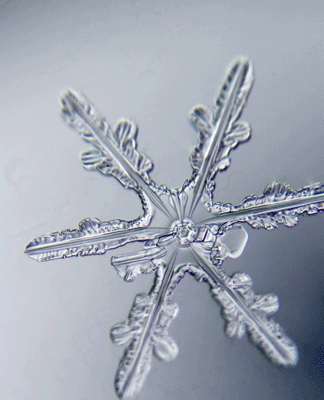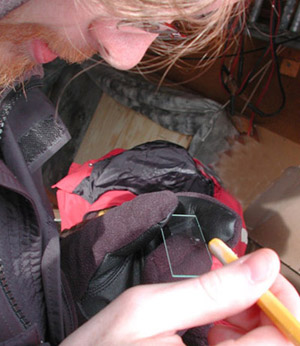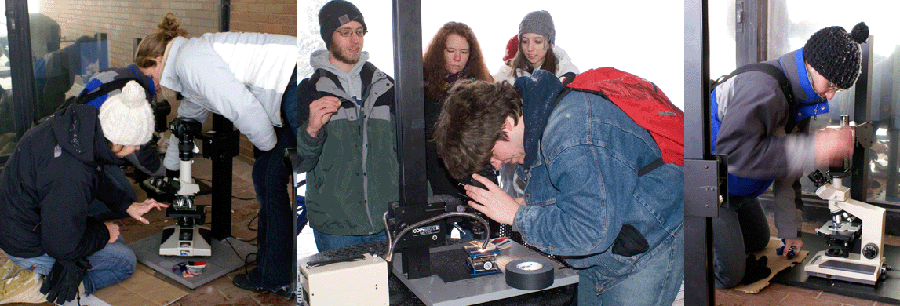

Photographing
Snowflakes
by Professor Michael Peres
people.rit.edu/mrppph
Students each winter in my Photography and the Microscope class have the chance to photograph one of our area’s most abundant natural resources
- snowflakes. In this class - first offered in 1988, students have
photographed nearly anything that has interested them. Cell phone screens, seeds, and the pieces and parts of anything imaginable. I often share, if you can see it under magnification, you can photograph it. Photographing snowflakes has
become an exciting addition to the class.
In 2002, an alumn, Emily Marshall was inspired
during her winter break by the b&w photomicrographs of snowflakes made
in the early 20th Century by photographer Wilson
Bentley.
Emily came back to campus all excited and shared, “We’ve got to
photograph snowflakes.” I responded that all of our equipment was
inside and there was no easy place to set it up, so it would be near impossible.
Later on the drive home, I felt that was a pretty lame excuse and I decided
that I should just take the microscopes outside, which I did the next day and try.
The first attempt was made in the RIT breezeway. It is a protected location however the wind
always blows there - hence the name - and so photographing and collecting the
flakes was nearly impossible. I then moved
a microscope to my garage, six miles from campus and made an attempt to make some photomicrographs there.
Besides a small microclimate that existed in the garage, working there was
just fine as long as the outside temperature was colder than 28 F. Since that time, a workbench in my garage holds several microscopes, fiber-optic
lights, a digital camera, and sometimes a computer during the winter waiting for a chance event.
Photographing snowflakes presents many challenges for the class. To make
really nice photomicrographs of snowflakes requires a bit of work and
some good luck. The flakes must be caught before touching the ground. I
accomplish this by using piece of black velvet that placed into old 8 x10 developing
tray. Since the typical Rochester winter averages more than 100+ inches of
snow, you might think there would be numerous opportunities but its actually quite lucky to have good flakes. Often they are needles, prisms, or non-descript snow. During the winter, I constantly watch the weather forecast and make
my best guess when we might have the chance for photographing snowflakes.
Rochester’s snow sometimes might come in feet or a gentle dusting. It
can be a good snow for photographing or ”ugly” snow. Once a flake
lands on the ground, they begin to change in small ways almost immediately and
so flakes must be caught and photographed before they join other ice
crystals and become entangled, changed, broken and/or dirty on the ground.
When photographing snowflakes, one quickly realizes there are many variables.
The snow may or may not be visually interesting. It
may appear like a pellet or needle instead of the expected flake. In Rochester, we get
a lot of what I refer to as “ugly snow”. Ugly snow in Rochester is most often
the result of our lake-effect snow. Photographing snowflakes is completely weather
dependent. It is difficult to predict the type of snow that will arrive
and even when much snow is in the forecast, it might not be condusive to photography. The formation of the flake itself
is dependent on many factors including the various temperatures it experiences from formation to falling, the relative humidity it existed in,
the altitiude and magnetic fields in the atmosphere at formation and condition during falling. There
are a great number of variables, which makes coordinating photography for the
class ever so complicated and nearly impossible as a group event. In fact,
it is a random event at best that a good snowfall occurs during the scheduled
class time.
Isolating snowflakes is fun, tricky and requires a bit of patience. The best flakes in Rochester
seem to be produced when the air temperatures are around 15 F and the snow
is not a product of the lake effect cycle. Photographing requires
patience in trying to isolate and transfer the best flakes to clean microscope
slides while working in the outdoors and sometimes at night. When the flake
is ready to be photographed, we use a variety of techniques such
as darkfield, Rheinberg or modified brightfield. What I have found is that the most successful
photos are the result of improvisation and the blending of multiple lighting
methods. For more about photographing snowflakes please take a quick look at this article I published in the Winter 2010 issue of the BPC Bulletin.


